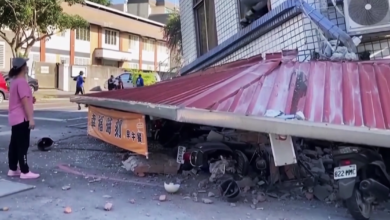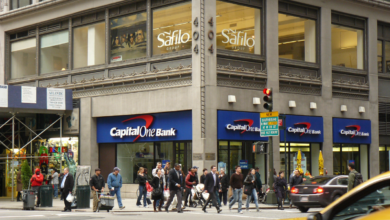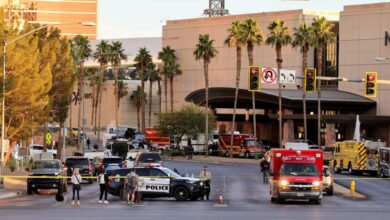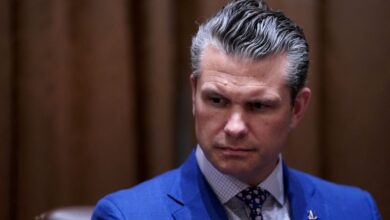Kilmar Abrego Garcia Returned to U.S. to Face Federal Charges After Mistaken Deportation
Kilmar Abrego Garcia, wrongly deported to El Salvador, has returned to the U.S. to face federal charges, fueling legal battles over immigration and due process.

Washington, DC.(WE) Kilmar Abrego Garcia, a Maryland resident, became the center of a legal and political storm after U.S. officials mistakenly deported him to El Salvador in March 2025. His case quickly escalated into a high-profile dispute between the Trump administration and the federal judiciary, raising serious questions about due process, immigration enforcement, and government accountability.
On Friday, Attorney General Pam Bondi announced that authorities had returned Abrego Garcia to the United States to face federal criminal charges. This development followed months of intense legal wrangling after courts ordered the government to facilitate his return from El Salvador, where officials had initially sent him following what they described as an “administrative error.”
The Criminal Charges and Indictment
After Abrego Garcia returned, federal prosecutors in the U.S. District Court for the Middle District of Tennessee indicted Kilmar Abrego Garcia on two criminal counts: conspiracy to unlawfully transport undocumented people for financial gain and unlawful transportation of undocumented people for financial gain.
The indictment, unsealed Friday afternoon, alleges that Abrego Garcia, along with other unnamed co-conspirators, engaged in a conspiracy spanning several years during which they knowingly transported thousands of undocumented migrants without authorization to be in the United States. Prosecutors assert that many of these migrants were members or associates of the violent gang MS-13, which the U.S. government has designated a foreign terrorist organization.
According to the indictment, the conspiracy involved multiple trips moving migrants between states such as Texas and Maryland, often using false cover stories to evade law enforcement. In one highlighted incident in November 2022, Abrego Garcia allegedly drove a Chevrolet Suburban on a Tennessee interstate with nine Hispanic male passengers, none of whom had identification or luggage.
Though the charges portray Abrego Garcia as a significant participant in this scheme, the indictment does not position him as the mastermind but rather one part of a larger network headed by other co-conspirators.
Abrego Garcia’s Defense and Background
Abrego Garcia and his family consistently deny any association with MS-13 or involvement in criminal activity. They maintain that he fled El Salvador seeking protection from rampant gang violence—a reality that thousands of Central American migrants face.
His attorney, Simon Sandoval-Moshenberg, has been a vocal critic of the government’s handling of the case, calling the prosecution an abuse of power and accusing the Trump administration of “playing games with the court.” Sandoval-Moshenberg emphasized that the government must allow Kilmar Abrego Garcia to defend himself in the proper immigration courts before punishing him, as due process requires.
“The government disappeared Kilmar to a foreign prison in violation of a court order. Now, after months of delay and secrecy, they’re bringing him back, not to correct their error but to prosecute him,” Sandoval-Moshenberg told the Media.
He further asserted that Abrego Garcia’s trial should be conducted by the same immigration judge who originally handled his case in 2019, in order to ensure fairness as mandated by the Supreme Court.
The Conspiracy Allegations in Detail
The indictment sheds light on a sprawling scheme dating back to 2016, involving multiple individuals, including co-conspirators identified only as CC-1, CC-2, and CC-6, the latter reportedly operating out of Guatemala and described as a “primary source of supply of undocumented aliens for the conspiracy.”
The operation is said to have involved over 100 transports of undocumented migrants across various states. According to the indictment, Abrego Garcia and a co-conspirator commonly picked up migrants in the Houston, Texas area after their unlawful entry into the U.S. from Mexico, then moved them onward to destinations across the country.
To avoid detection, Abrego Garcia and his alleged co-conspirators frequently concocted false stories for law enforcement, claiming that the migrants were headed to construction jobs or other legitimate employment opportunities.
The indictment also references the grave risks involved in such transport operations. It recounts a 2021 incident where over 50 migrants died after a tractor-trailer overturned in Mexico, an event linked to the co-conspirator CC-6.
Additionally, the indictment claims Abrego Garcia transported narcotics to Maryland, though he faces no criminal charges related to drug trafficking at this time.
The Deportation Mistake and Political Fallout
Abrego Garcia’s deportation to El Salvador in March was the result of an acknowledged “administrative error” by Immigration and Customs Enforcement (ICE). He was sent to one of El Salvador’s notorious mega-prisons, where he was held for several weeks before being transferred to another facility.
The mishandling of his case quickly became a political lightning rod for the Trump administration’s aggressive immigration policies. President Donald Trump himself made contradictory public statements regarding the possibility of Abrego Garcia’s return, initially denying the ability to secure it due to his detention in a foreign country, but later stating in an interview with ABC News that he could arrange for the man’s return.
“You could get him back. There’s a phone on this desk,” said ABC’s Terry Moran. “I could,” Trump responded.
This inconsistency and the administration’s prolonged delay in complying with court orders drew sharp criticism from legal experts, bipartisan lawmakers, and immigrant rights advocates. The case even prompted intervention from Democratic Senator Chris Van Hollen, who traveled to El Salvador to meet Abrego Garcia.
The administration’s refusal to return Abrego Garcia as ordered by the courts raised concerns about respect for judicial authority and the protection of constitutional rights.
Read More:
- Trump-Musk Fallout Sparks GOP Anxiety as Lawmakers Urge Reconciliation Amid Policy Clash
- Boulder, Colorado Attack: What We Know About the Suspect and Victims
- Joni Ernst Defends Medicaid Cuts: “We All Are Going to Die” Sparks Backlash
Judicial Orders and the Supreme Court
Abrego Garcia’s case reached the Supreme Court in April 2025. The justices ruled that the government must “facilitate” his return but stopped short of requiring them to “effectuate” it, leaving a degree of ambiguity.
This ruling allowed the administration to delay Abrego Garcia’s return for weeks, citing logistical challenges and diplomatic complications with the Salvadoran government led by President Nayib Bukele.
Lower court judges, including U.S. District Judge Paula Xinis, have expressed frustration with the administration’s stance, warning of an “incipient crisis” between the executive branch and the judiciary.
Judge Xinis barred the government from removing Abrego Garcia to El Salvador in 2019, citing credible fears that he would face violence from gangs upon return. However, the 2019 order did not explicitly forbid removal to a third country, which the government initially argued as grounds for his deportation.
The government’s position further complicated the case, as ICE officials conceded they considered relocating Abrego Garcia to another country if he returned to the U.S., raising concerns about his ultimate fate.
Broader Immigration Enforcement Issues
Abrego Garcia’s deportation was not an isolated incident. The Trump administration has faced accusations of wrongfully deporting multiple individuals due to administrative errors and expedited removals under its crackdown on illegal immigration.
One such case involved a Guatemalan national who was mistakenly deported to Mexico and later managed to return to the U.S.
Advocates argue that these errors reflect systemic problems within immigration enforcement agencies, including inadequate safeguards to protect migrants’ rights and due process.
The controversy surrounding Abrego Garcia also highlights the broader debate over immigration policy, enforcement priorities, and humanitarian obligations.
The Human Cost and Risks of Migration
At the core of this saga lies the plight of migrants fleeing violence, poverty, and instability in Central America, particularly in countries like El Salvador, Guatemala, and Honduras.
According to the United Nations High Commissioner for Refugees (UNHCR), gang violence and persecution remain significant drivers of forced displacement in the region.
Many migrants undertake perilous journeys through Mexico and the U.S. southern border, often relying on smugglers and traffickers who exploit their desperation.
The indictment in Abrego Garcia’s case references tragic incidents such as the 2021 trailer accident in Mexico that killed more than 50 migrants—an example of the dangers migrants face during clandestine transport.
Looking Ahead: Legal Battles and Policy Implications
Kilmar Abrego Garcia’s return to the United States marks a new chapter in a complex legal battle. His defense team insists on a fair hearing in immigration court to review his claim for protection.
Meanwhile, federal prosecutors are prepared to pursue the criminal charges outlined in the indictment, further complicating his case.
The situation underscores the tensions between immigration enforcement and judicial oversight. It also illustrates the challenges of managing immigration in a manner that respects both security concerns and human rights.
The Trump administration’s handling of the case has drawn criticism from various quarters for perceived disregard of court orders and due process safeguards.
For policymakers, the case may serve as a cautionary tale about the need for clear procedures, transparency, and accountability in immigration enforcement to prevent miscarriages of justice.
As this case unfolds, its impact will likely extend beyond one man’s fate, potentially influencing immigration policy debates, legal standards, and executive-judicial relations in the United States.















